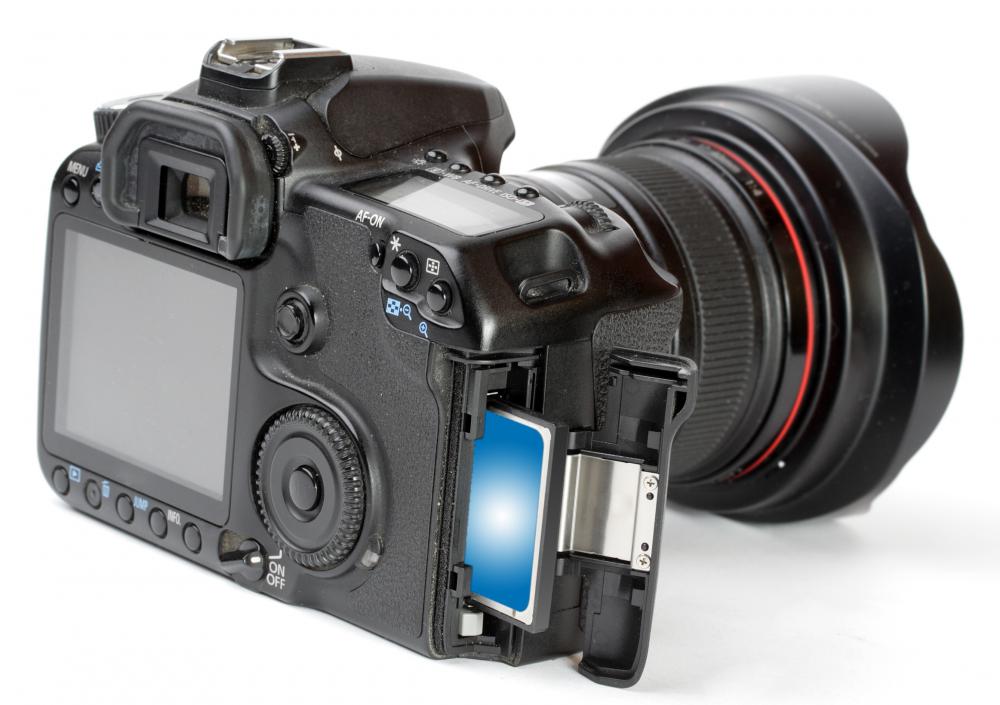At WiseGEEK, we're committed to delivering accurate, trustworthy information. Our expert-authored content is rigorously fact-checked and sourced from credible authorities. Discover how we uphold the highest standards in providing you with reliable knowledge.
What is a Wireless SD Card?
Secure Digital, or SD, cards, are one of the standard formats of portable memory cards. Originally developed by SanDisk, Toshiba, and Matsushita, they are now, along with CompactFlash cards, the most common memory cards in portable devices. A wireless SD card takes the functions of a traditional SD card and adds wireless capabilities to it, as well as various features that wireless allows.
One of the most obvious benefits of a wireless SD card is the ability for data grabbed by the card to be seamlessly sent to other, wireless-capable devices. So, for example, a digital camera utilizing a wireless SD card could send its images straight to a wireless-capable computer, or print directly to a wireless-capable printer that it has paired with. And devices like MP3 players could use the wireless SD card to acquire or send music or video files straight to a computer, or even, in theory, directly to other wireless SD cards, giving the media players limited de facto wireless capabilities.

Although the wireless SD card concept has been around since at least 2003, it wasn’t until the Eye-Fi™ wireless SD card that the idea saw a massive market penetration. The Eye-Fi™ is currently the only widely available wireless SD card on the market, and has a number of different varieties available, each with different features that utilize wireless capabilities. A number of different SD manufacturers have their own utilizations planned, and the future of SD memory is likely to be full of wireless SD cards.

Eye-Fi™ wireless cards make use of 2GB SD cards, allowing a fair amount of storage for a reasonable price. There are three varieties of Eye-Fi™ currently available: the Home model, the Share model, and the Explore model. The Home model is priced at around $80 US Dollars (USD) for a 2GB card, the Share model is priced at around $100 USD, and the Explore is priced at around $130 USD. Comparable non-wireless 2GB cards by major manufacturers like SanDisk and Kingston are in the $5 USD to $15 USD range.
The Home model is capable of simply uploading images directly from your digital camera to your computer at home, using a wireless network. It does this seamlessly, and can include many different settings that let you configure which images are sent, how they are flagged, and where they are saved. The Share model includes this capability, but adds to it the ability to automatically upload photos you take to a photo-sharing service of your choosing. This includes sites like Facebook, Picassa, Flickr, and Snapfish, and this also happens seamlessly as soon as you enter a wireless hotspot. The automatic upload mode can be turned off, for privacy, and only selected photos can be uploaded.
Perhaps the most robust implementation of the wireless SD card is in the Explore model, which makes use of geo-tagging to locate your photographs in the world. Coordinates are sent along with the photograph when images are uploaded to your computer or to online sites, allowing them to be plotted on a map, either in compatible software or on sites that include geo-tagging capabilities. Many people see this feature as likely to push the geo-tagging movement to the next step as more and more people adopt wireless SD cards, creating an abundance of geo-tagged photographs online.
AS FEATURED ON:
AS FEATURED ON:












Discussion Comments
It's a great bonus for camera owners, but can it be used on phones as my RAVPower 4-in-1 Wi-Fi Filehub is?
Does anyone know how big these wireless SD cards get?
I think it would be great if you had one that could be used in your digital video camera. It would certainly make for a lot more space if you could send your video files straight to an online virtual drive.
On that note, is it possible to continuously send files, as you create them, to an online source?
That would be even better, as you could in theory make very large files and just not save them to your physical device.
Having a wireless SD card in your camera is a great time saver. I used to hate having to take out my card and find my reader, only to have to wait for my software to kick in. Then there was the long process of making sure the photos were heading to the correct folders et cetera.
Now, my wireless SD card does all of that for me. I just let it have access to a WiFi network and it sends my images wherever I want them to go.
This is a great feature, as it also saves me having to carry multiple cards. Once my files are transferred, I can just delete the images off my card and continue shooting. This is really a great product.
Post your comments